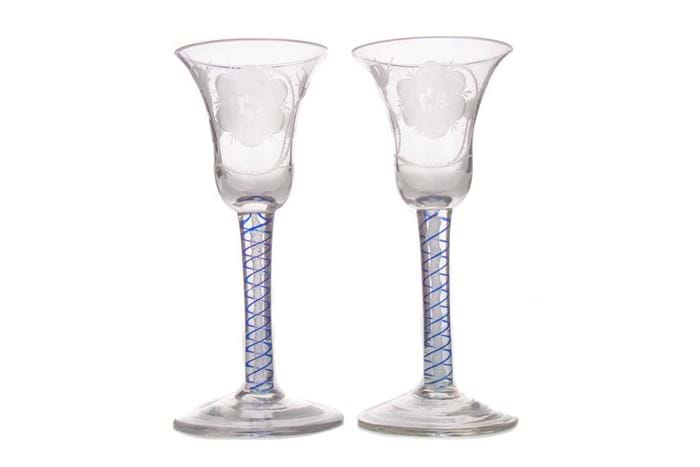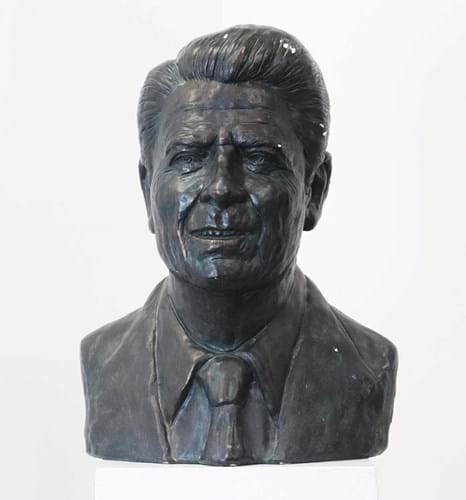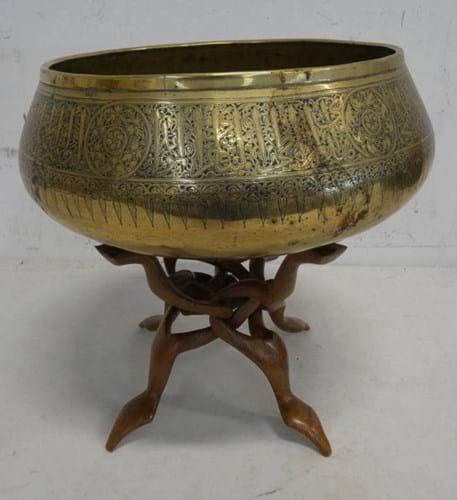1. Islamic brass bowl – £11,000
Estimated at a mere £20-40, this Islamic brass bowl on a later associated stand sold for £11,000 at Taylors in Montrose on February 6. The 12in (31cm) vessel, of typical form with rounded base and sloping shoulder, came for sale from a private estate in the Aberdeenshire area from a family whose ancestors had travelled extensively in the 19th century.
However, this was not a revivalist piece of the type that many Victorian and Edwardian tourists bought back from the Near East.
Closer inspection suggests it is likely 14th century in date. Often originally inlaid in gold or silver, many of these were made in the Fars region in the west of Iran during the Ilkhanid period and some in Mamluk Egypt and Syria. The inscriptions are typically thuluth prayer inscriptions alongside the name or names of the bowl’s first owners.
2. Japanned coffre fort – £12,500
In order to try and recreate the effect of imported oriental lacquer work, European cabinet makers turned to John Stalker and George Parker’s 1688 publication, Treatise of Japanning and Varnishing. The book soon became a key reference work, since it contained not only recipes for producing the various different colours but also patterns of Chinese figures, plants and gardens which could be adapted as necessary.
‘Japanning’ was approaching the peak of fashion when this 2ft 4in (70cm) wide casket or coffres forts was made c.1690.
Decorated two the doors with exotic flowers, birds, foliage and butterflies, it is mounted in ormolu and veneered inside in rosewood.
These strongboxes are European in concept and many were made on the continent. However, there are documented examples made in England including some made by the Dutch or Flemish cabinetmaker Gerrit Jensen (fl.1667-d.1715), who worked in London.
Offered on a modern stand, this japanned example dated to the James II or William and Mary period sold for £12,000 (estimate £1500-2500) as part of the Connoisseur Library Sale held at Bonhams on February 7-8.
3. Jacobite glasses – £8000

A pair of 18th century cordial glass with colour twist stems and Jacobite style engraving, £8000 at McTears.
Jacobite glasses, those engraved with symbols honouring the Stuart succession, are among the best-known of all Georgian drinking glasses. This pair, with white and blue enamel double twist stems, carry the motif of a rose and a bud (representing Bonnie Prince Charlie and his brother Henry) and a butterfly representing the hope for the Stuarts’ grand return from exile.
They evidently posed something of a puzzle when they came up at McTears in Glasgow. While the glass was deemed 18th century, it was quite possible that the engraving was a later addition – perhaps added in the late 19th or early 20th century when interest in Jacobite collecting first began.
The colour twist stems were nonetheless a great draw and, guided at just £100-150, this pair of wine glass sold for £8000.
4. Georgian paste parure – £20,000
Aided by the skills of the Alsatian jeweller Georges-Frédéric Strass (1701-77), the boundaries of what could be achieved with paste jewellery were pushed back in the 18th century. It was Strass who cornered the market for artificial gemstones at the French court, creating ‘diamonds’ first from rock crystal gathered from the Rhine (hence the name ‘rhinestone’) and then from leaded glass.
Treated with chemicals and backed with foil to add colour, depth, shine, paste became hugely important in Georgian jewellery. Replicating the brilliance of precious stones at a fraction of a cost, it could aid with security (travelling with jewellery was notoriously risky) and proved an art form in its own right. Much of it was finely made by specialists or by the same craftsmen who worked with gemstones.
In collecting terms paste offers great possibilities. Often dismissed as mere ‘costume’ jewellery, it is often considered the ultimate expression of design and craftsmanship over intrinsic value.
While many 18th century jewels were broken up for their stones and reset in more fashionable styles, paste has a much better survival rate. The Georgian ‘Queen Anne' paste parure offered at Woolley & Wallis on February 1 dated from the middle of the 18th century. It comprised a necklace suspending a pendant, with hoops for fastening via a ribbon, a similar bracelet and a pair of earrings each set with vibrant 'peacock blue' stones.
That a similar pendant drop necklace with deep blue stones sold a year ago at Catherine Southon for £3900 did make the £200-300 estimate on this Salisbury set look a little lightweight. And so it proved when the suite was sold at a mighty £20,000.
5. Ronald Reagan bust – £9000

Bronzed plaster bust of Ronald Reagan purportedly presented to Margaret Thatcher, £9000 at Sworders.
Memorabilia given to Margaret Thatcher but found in a waste disposal site in London 20 years ago formed part of the Out of the Ordinary sale at Sworders in Essex on February 7.
“The collection came to us from someone whose father had owned a storage company during the 1980s, and helped move Margaret Thatcher out of No 10 in November 1990,” said Otto Billstrom, 20th century design specialist at Sworders. “Her people put these pieces in storage, it was probably forgotten about, and our vendor’s father ended up salvaging them when they were sent for disposal a decade later.”
Of particular note was this large 22in (56cm) bronzed plaster bust of President Ronald Reagan purportedly presented to Margaret Thatcher by ‘the Gipper’ as a gift during the state visit in 1982. Estimated at £500-700, it made £9000.
An (unsigned) oil painting of the Iron Lady seated in blue dress on a green armchair that carried a brass plaque detailing its presentation ‘From a true friend and admirer with sincere best wishes on your birthday, 13th October 1995’. The dedication was signed by Professor Bacharuddin Jusuf Habibie, a minister and future Prime Minister of Indonesia. It took £1100.
Another lot comprised a walnut box bearing a plaque inscribed 'Presented to Former Prime Minister Margaret Thatcher on the occasion of Her visit to Bellingham International Airport, March 15 1991’. It was offered together with a (more commercially attractive) photograph presented to Margaret Thatcher by the 22nd SAS Regiment after the storming of the Iranian embassy at the end of the Iranian Embassy Siege in 1980. The framed photo of the Prime Minister flanked by three soldiers in gas masks holding assault rifles is inscribed 'To Mrs Margaret Thatcher From 22 SAS Regt'. The two items sold for £1500.








